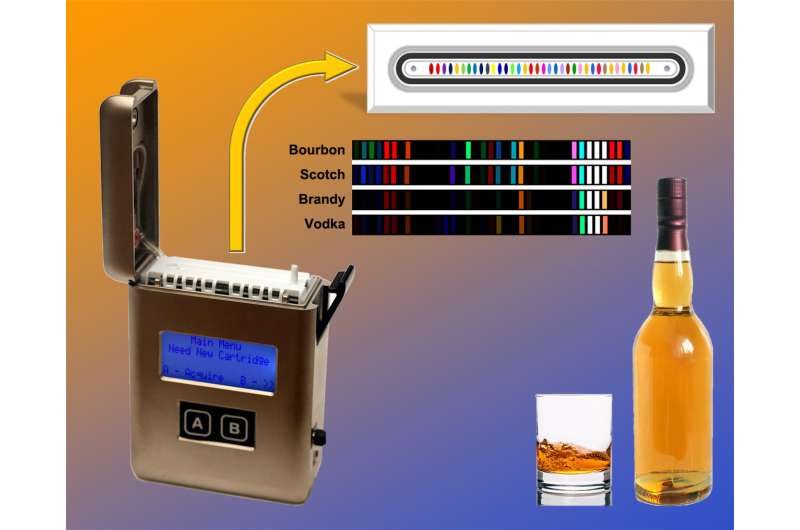'Sniffing' out counterfeit liquors

Watered-down or fake liquors can reap financial rewards for nefarious individuals, but the adulteration of liquor cheats consumers and can even lead to health hazards from added contaminants. Scientists now report in ACS Sensors a portable device with an advanced sensor array that can identify liquors and determine if they'd been altered, offering a strategy for liquor quality assurance.
In the past few years, deaths from contaminated alcohol have been reported in Indonesia, Mexico, China, Poland and Russia, among other places. Unscrupulous individuals hoping to make a profit may homebrew liquor and bottle it in official-looking packaging or dilute liquor with anything from water to antifreeze. Kenneth S. Suslick and Zheng Li from the University of Illinois at Urbana-Champaign wanted to address this growing health concern by engineering a device that can easily identify tainted products.
The researchers developed a disposable sensor with 36 dyes that change color upon exposure to particular components in liquor. Partial oxidation of the liquor vapors improved the sensor's response. Using a handheld image analyzer to detect these color changes, the scientists correctly identified the alcoholic content and brand of 14 different liquors, including various scotch whiskies, bourbon, rye, brandy and vodka with greater than 99 percent accuracy. In a proof-of-concept experiment to demonstrate a real-world application, the researchers also sniffed out booze that had been watered down, even by as little as 1 percent.
More information: Zheng Li et al. A Hand-Held Optoelectronic Nose for the Identification of Liquors, ACS Sensors (2017). DOI: 10.1021/acssensors.7b00709
Abstract
Successful discrimination of 14 representative liquors (including scotch, bourbon and rye whiskies, brandy, and vodka) was achieved using a 36-element colorimetric sensor array comprising multiple classes of cross-reactive, chemically responsive inks. In combination with a palm-sized image analyzer, the sensor array permits real-time identification of liquor products based on vapor analysis within 2 min. Changes in sensor spot colors before and after exposure to the vapors of the liquors that are partially oxidized as they are pumped over the sensor array provides a unique color difference pattern for each analyte. Facile identification of each liquor was demonstrated using several different multivariate analyses of the digital data library, including principal component, hierarchical cluster, and support vector machine analysis. The sensor array is also able to detect dilution (i.e., "watering") of liquors even down to 1% addition of water. This colorimetric sensor array is a promising portable adjunct to other available techniques for quality assurance of liquors and other alcoholic beverages.
Journal information: ACS Sensors
Provided by American Chemical Society

















